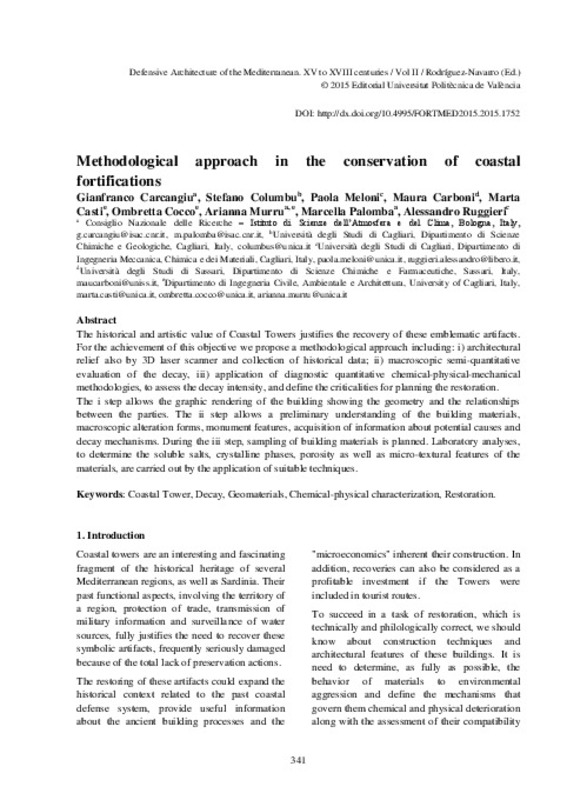JavaScript is disabled for your browser. Some features of this site may not work without it.
Buscar en RiuNet
Listar
Mi cuenta
Estadísticas
Ayuda RiuNet
Admin. UPV
Methodological approach in the conservation of coastal fortifications
Mostrar el registro sencillo del ítem
Ficheros en el ítem
| dc.contributor.author | Carcangiu, Gianfranco
|
es_ES |
| dc.contributor.author | Columbu, Stefano
|
es_ES |
| dc.contributor.author | Meloni, Paola
|
es_ES |
| dc.contributor.author | Carboni, Maura
|
es_ES |
| dc.contributor.author | Casti, Marta
|
es_ES |
| dc.contributor.author | Cocco, Ombretta
|
es_ES |
| dc.contributor.author | Murru, Arianna
|
es_ES |
| dc.contributor.author | Palomba, Marcella
|
es_ES |
| dc.contributor.author | Ruggieri, Alessandro
|
es_ES |
| dc.date.accessioned | 2018-01-24T10:22:26Z | |
| dc.date.available | 2018-01-24T10:22:26Z | |
| dc.date.issued | 2015-10-16 | |
| dc.identifier.isbn | 9788490483770 | |
| dc.identifier.uri | http://hdl.handle.net/10251/95434 | |
| dc.description.abstract | [EN] The historical and artistic value of Coastal Towers justifies the recovery of these emblematic artifacts. For the achievement of this objective we propose a methodological approach including: i) architectural relief also by 3D laser scanner and collection of historical data; ii) macroscopic semi-quantitative evaluation of the decay, iii) application of diagnostic quantitative chemical-physical-mechanical methodologies, to assess the decay intensity, and define the criticalities for planning the restoration. The i step allows the graphic rendering of the building showing the geometry and the relationships between the parties. The ii step allows a preliminary understanding of the building materials, macroscopic alteration forms, monument features, acquisition of information about potential causes and decay mechanisms. During the iii step, sampling of building materials is planned. Laboratory analyses, to determine the soluble salts, crystalline phases, porosity as well as micro-textural features of the materials, are carried out by the application of suitable techniques. | es_ES |
| dc.format.extent | 4 | es_ES |
| dc.language | Español | es_ES |
| dc.publisher | Editorial Universitat Politècnica de València | es_ES |
| dc.relation.ispartof | Defensive architecture of the mediterranean: XV to XVIII centuries. Vol. I | es_ES |
| dc.rights | Reconocimiento - No comercial - Sin obra derivada (by-nc-nd) | es_ES |
| dc.subject | Fortifications | es_ES |
| dc.subject | Mediterranean | es_ES |
| dc.subject | Modern age | es_ES |
| dc.subject | Built Heritage | es_ES |
| dc.subject | Coastal Tower | es_ES |
| dc.subject | Decay | es_ES |
| dc.subject | Geomaterials | es_ES |
| dc.subject | Chemical-physical characterization | es_ES |
| dc.subject | Restoration | es_ES |
| dc.title | Methodological approach in the conservation of coastal fortifications | es_ES |
| dc.type | Capítulo de libro | es_ES |
| dc.type | Comunicación en congreso | es_ES |
| dc.identifier.doi | 10.4995/FORTMED2015.2015.1752 | |
| dc.rights.accessRights | Abierto | es_ES |
| dc.description.bibliographicCitation | Carcangiu, G.; Columbu, S.; Meloni, P.; Carboni, M.; Casti, M.; Cocco, O.; Murru, A.... (2015). Methodological approach in the conservation of coastal fortifications. En Defensive architecture of the mediterranean: XV to XVIII centuries. Vol. I. Editorial Universitat Politècnica de València. 341-344. https://doi.org/10.4995/FORTMED2015.2015.1752 | es_ES |
| dc.description.accrualMethod | OCS | es_ES |
| dc.relation.conferencename | FORTMED2015 - International Conference on Modern Age Fortifications of the Western Mediterranean coast | es_ES |
| dc.relation.conferencedate | October 15-17,2015 | es_ES |
| dc.relation.conferenceplace | Valencia, Spain | es_ES |
| dc.relation.publisherversion | http://ocs.editorial.upv.es/index.php/FORTMED/FORTMED2015/paper/view/1752 | es_ES |
| dc.description.upvformatpinicio | 341 | es_ES |
| dc.description.upvformatpfin | 344 | es_ES |
| dc.type.version | info:eu-repo/semantics/publishedVersion | es_ES |
| dc.relation.pasarela | OCS\1752 | es_ES |








